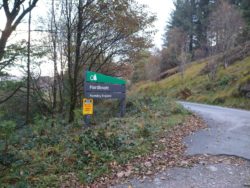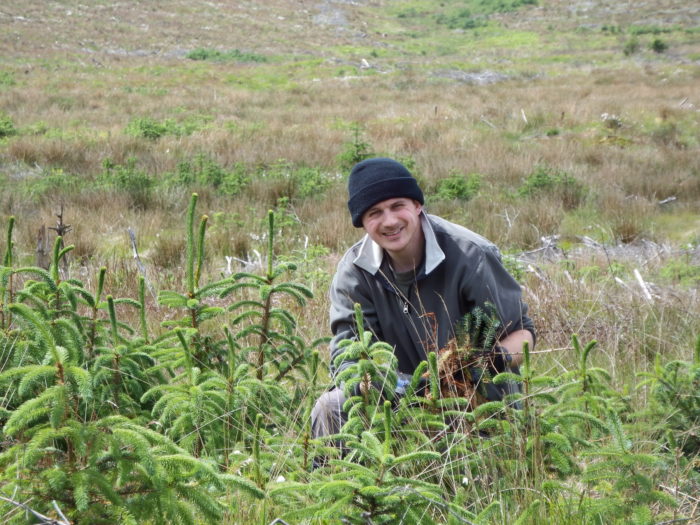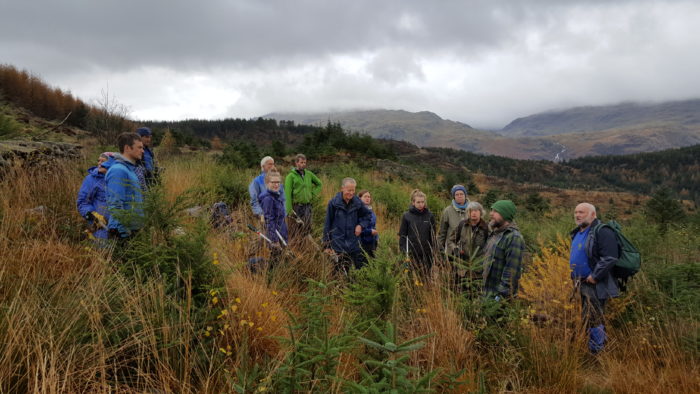Volunteering at Hardknott Forest
"VOLUNTEERING AT HARDKNOTT FOREST" by John Hodgson, Project Officer, August 2021
After the ups and downs of the past 18 months, our volunteering program is once again fully underway. With a steady stream of enquiries from people new to volunteering, it’s a good time to provide a description of what to expect on a volunteer day at Hardknott Forest.

The structure of the day.
We meet at 9.30am at the Forestry England car park at Hardknott Forest, tools and work gloves are handed out, and we make our way to our work site for the day. This is an important time for people to get to know their fellow volunteers, or to meet up with others they’ve met before. We usually get a mixture of ages, experiences and backgrounds, so there are plenty of opportunies to get to know new people and swap stories. This is also a good time to discuss the background to the project, and what we do and why - there’s always an educational element to our volunteer days.
With a large area to work in, the walk to the site is always an interesting part to the day, with opportunities for some wildlife spotting or tree identification, and a chance to give context to the day’s work. Although most tasks are fairly straightforward, it’s important to give everyone the information they need to do a good job – and we make sure everyone is involved and looked after. Some like to work alone and are very task focussed, others really appreciate the chat and the company. People work at their own pace with plenty of breaks, and of course some quality banter*.
(*banter quality cannot be guaranteed. Terms and Conditions apply.)
The tasks
Non-native tree removal
We’re very fortunate at Hardknott Forest in that we have ideal conditions for native trees to regenerate naturally, so we don’t need to do huge amounts of tree planting. The most common task is the removal of small regenerating conifer saplings, either by using long handled garden loppers, or our top-of-the-range Silky pruning saws (be aware you’ll want to buy one for yourself once you have used one).
Removing the non-native tree species (non-native removal, or NNR) gives the native species such as Rowan, oak and birch a better chance, and it’s always encouraging to see the variety and number of self-seeded native trees which we find during an NNR session.

Tree planting
We do plant small numbers trees during the planting season, and focus on rarer species such as Aspen, Wild cherry and Small-leaved lime. This is known as enrichment planting. Some of our volunteers are also propagating trees for us, for example oak from acorns collected on site. We now have a small group of volunteers growing other plants such as Water avens, Globeflower and Devil’s-bit scabious.
Education and training
Project staff run various educational events throughout the year. This includes drystone walling for beginners, wildlife walks and learning how to use wildlife cameras.
Other tasks
As well as NNR and tree planting, there’s a variety of other tasks throughout the year. This includes tree tube removal and maintenance, seed collection and monitoring work. We also work with neighbouring farmers and landowners to support their ongoing restoration projects. There are opportunities to help run stalls at events, distribute leaflets or raise money for the project.
Residentials
We've recently restarted our residential weekends where you can come and join us for two days of forest restoration activities. Even more time to enjoy the local scenery, wildlife and a well-earned pub dinner! We can also organise days for schools, workplaces, community groups and special interest groups. Sign up to the newsletter to hear about these.

The work itself is very satisfying, knowing I am helping in a very small way to restore natural habitat and native tree cover. It is quite physical so provides an opportunity to exercise, be outdoors and to be with like-minded people, all things that make me feel happy and connected. I would say that being close to nature in a wild environment is essential to my personal sense of well-being.
Katy, Restoring Hardknott Forest volunteer
The experience
It can be easy to underestimate what else people get from the experience of working outdoors. Of course the task of restoring natural habitats, and the associated benefits to the environment and wildlife are obvious, and (relatively) easy to quantify. However the less measureable positives are often those which are of more immediate benefit to the participants – and this was particularly noticeable as we came out of lockdown. Spaces on volunteer days were filling almost as soon as we advertised them, and volunteers were relishing the chance to get out, mix with people, and participate in something positive and meaningful.
All welcome
We are always grateful for help, whether you are able to come on a volunteering day, or several, or can help in any other way. And if you’ve already been a part of the volunteering team – many thanks.
John Hodgson, Project Officer
j.h.hodgson@leeds.ac.uk
Current volunteering dates are here.
Sign up to the newsletter here.
